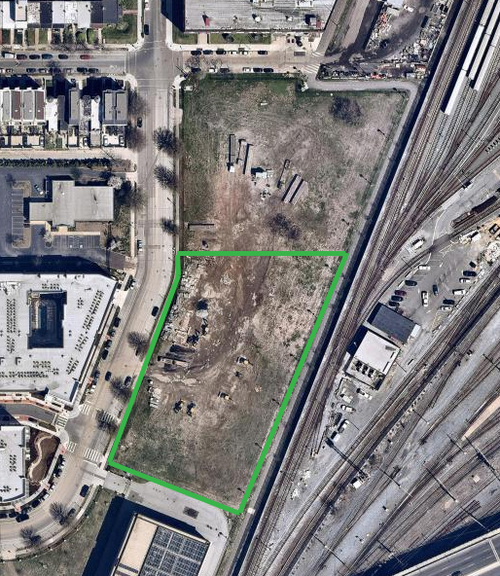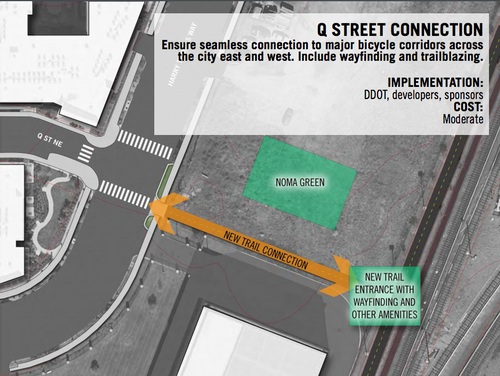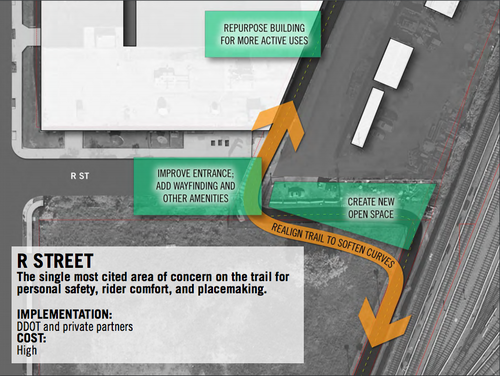NoMa is going to get the large park it needs
A two-acre plot of land next to the Metropolitan Branch Trail will one day be NoMa’s largest park. That’s great news for an area that plans to add another 7,000 residential units and numerous new shops and amenities over the next few years.
The NoMa Parks Foundation bought the land between the MBT and Harry Thomas Way, just before the new year. There’s a Pepco substation that will remain at the southern end of the plot adjacent to New York Avenue.
The Foundation is temporarily calling the land the NoMa Green.

The plot. The straight line that runs diagonally through the right half of the picture is the MBT. Image from NoMa BID.
“People want an area for informal recreation and relaxation,” says Robin-Eve Jasper, president of the NoMa Business Improvement District (BID), which includes the parks foundation. “Something beautiful, something that really integrates with the Metropolitan Branch Trail.”
The two-acre space is roughly comparable to Folger Park in Capitol Hill and slightly smaller than the 2.75-acre Canal Park in Navy Yard.
Designs for the space will take time. NoMa plans to hire a designer from among those who have “done the best work for these kinds of parks” and then hold a community design forum for the space before finalising any plans, says Jasper. This is unlikely to begin for at least three months, she adds.
Based on the speed of the underpass projects in NoMa, the first of which on M St NE was initially targeted for installation last fall, suggests a summer start for the NoMa Green design process.
NoMa has not finalised the design budget for the park since spending $14 million to buy the land from Pepco.
Connectivity will be part of the new park
The MBT will be the primary access route to the NoMa Green, says Jasper. Some of the improvements outlined in the BID’s MBT Safety and Access Study, including a Q Street connection, will likely be included in the project, she continues.
The Q Street connection involves extending the street from its current terminus Harry Thomas Way across the green to the MBT.
Long-term NoMa envisions activating the underpass at New York Ave like what is planned for the L Street and M Street underpasses and connecting the trail to Union Market and eventually Ivy City.
‘The most important thing we’ll do’
The NoMa Green is big. It guarantees that the neighborhood, which is slated to become the densest in Washington DC when it is built out, and those around it, including Eckington and Bloomingdale, will have green space.
“It’s huge for the neighborhood,” says Jasper. “To be able to have two acres for the people of the neighborhood to use and play on — it’s probably the most important thing we’ll do.”
With the purchase of the plot from Pepco and the deal for a lot at 3rd Street and L Street NE in October, NoMa will shift gears into a design and construction phase, after years of studies and conceptual plans, over the next few years.
Jasper anticipates the first parks — not including the L Street and M Street underpasses that she anticipates will be done later this year — will begin opening over the next couple of years.
The parks cannot come soon enough. NoMa estimates that 36,000 people live within a two sqaure mile radius of 1st Street and M Street and 1st and K Street NE — an area that stretches north to Rhode Island Avenue, south to Union Station, east to 10th Street NE and west to 6th Street NW— and anticipates another 7,000 residential units to open in its more immediate environs by 2018.
“What you’re going to have here… you’re going to get parks, shopping, retail and restaurants — it’s going to be quite an amazing place,” says Jasper.
Correction: The original version of this article said the plot extends north to R Street NE when it does not. In addition, it misstated the number of people living within a two-square mile radius of NoMa at 67,000. The correct number is 36,000.



